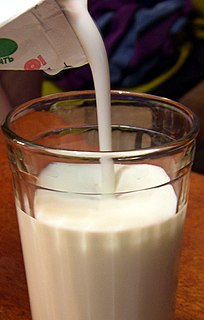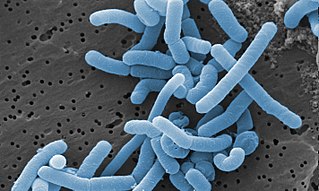
Angiotensin-converting-enzyme inhibitors are a class of medication used primarily for the treatment of high blood pressure and heart failure. They work by causing relaxation of blood vessels as well as a decrease in blood volume, which leads to lower blood pressure and decreased oxygen demand from the heart.

Swiss cheese is any variety of cheese that resembles Emmental cheese, a yellow, medium-hard cheese that originated in the area around Emmental, Switzerland. It is classified as a Swiss-type or Alpine cheese. Some types of Swiss cheese have a distinctive appearance, as the blocks or rounds of the cheese are riddled with holes known as "eyes". Swiss cheese without eyes is known as "blind".

Yogurt also spelled yoghurt, yogourt or yoghourt, is a food produced by bacterial fermentation of milk. The bacteria used to make yogurt are known as yogurt cultures. Fermentation of sugars in the milk by these bacteria produces lactic acid, which acts on milk protein to give yogurt its texture and characteristic tart flavor. Cow's milk is the milk most commonly used to make yogurt. Milk from water buffalo, goats, ewes, mares, camels, and yaks are also used to produce yogurt. The milk used may be homogenized or not. It may be pasteurized or raw. Each type of milk produces substantially different results.

Lactic acid is an organic acid. It has a molecular formula CH3CH(OH)COOH. It is white in the solid state and it is miscible with water. When in the dissolved state, it forms a colorless solution. Production includes both artificial synthesis as well as natural sources. Lactic acid is an alpha-hydroxy acid (AHA) due to the presence of a hydroxyl group adjacent to the carboxyl group. It is used as a synthetic intermediate in many organic synthesis industries and in various biochemical industries. The conjugate base of lactic acid is called lactate.

Lactobacillus is a genus of Gram-positive, aerotolerant anaerobes or microaerophilic, rod-shaped, non-spore-forming bacteria. Until 2020, the genus Lactobacillus comprised over 260 phylogenetically, ecologically, and metabolically diverse species; a taxonomic revision of the genus assigned lactobacilli to 25 genera.

Lactic acid fermentation is a metabolic process by which glucose or other six-carbon sugars are converted into cellular energy and the metabolite lactate, which is lactic acid in solution. It is an anaerobic fermentation reaction that occurs in some bacteria and animal cells, such as muscle cells.

Lactobacillus delbrueckii subsp. bulgaricus is one of over 200 published species in the Lactobacillus genome complex (LGC) and is the main bacterium used for the production of yogurt. It also plays a crucial role in the ripening of some cheeses, as well as in other processes involving naturally fermented products. It is defined as homofermentive lactic acid bacteria due to lactic acid being the single end product of its carbohydrate digestion. It is also considered a probiotic.

Probiotics are live microorganisms promoted with claims that they provide health benefits when consumed, generally by improving or restoring the gut flora. Probiotics are considered generally safe to consume, but may cause bacteria-host interactions and unwanted side effects in rare cases. There is some evidence that probiotics are beneficial for some conditions, but there is little evidence for many of the health benefits claimed for them.

Lactobacillus acidophilus is a species of Gram-positive bacteria in the genus Lactobacillus. L. acidophilus is a homofermentative, microaerophilic species, fermenting sugars into lactic acid, and grows readily at rather low pH values and has an optimum growth temperature of around 37 °C (99 °F). L. acidophilus is found in the human and animal gastrointestinal tract and mouth. Some strains of L. acidophilus may be considered to have probiotic characteristics. These strains are commercially used in many dairy products, sometimes together with Streptococcus thermophilus and Lactobacillus delbrueckii subsp. bulgaricus in the production of acidophilus-type yogurt, or acidophiline. Its genome has been sequenced.
Lactiplantibacillus plantarum is a widespread member of the genus Lactiplantibacillus and commonly found in many fermented food products as well as anaerobic plant matter. L. plantarum was first isolated from saliva. Based on its ability to temporarily persist in plants, the insect intestine and in the intestinal tract of vertebrate animals, it was designated as a nomadic organism. L. plantarum is Gram positive, bacilli shaped bacterium. L. plantarum cells are rods with rounded ends, straight, generally 0.9–1.2 μm wide and 3–8 μm long, occurring singly, in pairs or in short chains. L. plantarum has one of the largest genomes known among the lactic acid bacteria and is a very flexible and versatile species. It is estimated to grow between pH 3.4 and 8.8. Lactiplantibacillus plantarum can grow in the temperature range 12 °C to 40 °C. The viable counts of the "L. plantarum" stored at refrigerated condition (4 °C) remained high, while a considerable reduction in the counts was observed stored at room temperature.

Lacticaseibacillus casei shirota is an organism that belongs to the largest genus in the family Lactobacillaceae, a lactic acid bacteria (LAB), that was previously classified as Lactobacillus casei-01. This bacteria has been identified as facultatively anaerobic or microaerophilic, acid-tolerant, non-spore-forming bacteria. The taxonomy of this group has been debated for several years because researchers struggled to differentiate between the strains of L. casei and L. paracasei. It has recently been accepted as a single species with five subspecies: L. casei subsp. rhamnosus, L. casei subsp. alactosus, L. casei subsp. casei, L. casei subsp. tolerans, and L. casei subsp. pseudoplantarum. The taxonomy of this genus was determined according to the phenotypic, physiological, and biochemical similarities.
Limosilactobacillus reuteri is a lactic acid bacterium found in a variety of natural environments, including the gastrointestinal tract of humans and other animals. It does not appear to be pathogenic and may have health effects.
Leuconostoc mesenteroides is a species of lactic acid bacteria associated with fermentation, under conditions of salinity and low temperatures. In some cases of vegetable and food storage, it was associated with pathogenicity. L. mesenteroides is approximately 0.5-0.7 µm in diameter and has a length of 0.7-1.2 µm, producing small grayish colonies that are typically less than 1.0 mm in diameter. It is facultatively anaerobic, Gram-positive, non-motile, non-sporogenous, and spherical. It often forms lenticular coccoid cells in pairs and chains, however, it can occasionally forms short rods with rounded ends in long chains, as its shape can differ depending on what media the species is grown on. L. mesenteroides grows best at 30°C, but can survive in temperatures ranging from 10°C to 30°C. Its optimum pH is 5.5, but can still show growth in pH of 4.5-7.0.

Streptococcus thermophilus also known as Streptococcus salivarius subsp. thermophilus is a gram-positive bacterium, and a fermentative facultative anaerobe, of the viridans group. It tests negative for cytochrome, oxidase, and catalase, and positive for alpha-hemolytic activity. It is non-motile and does not form endospores. S. thermophilus is fimbriated.
Levilactobacillus brevis is a gram-positive, rod shaped species of lactic acid bacteria which is heterofermentative, creating CO2, lactic acid and acetic acid or ethanol during fermentation. L. brevis is the type species of the genus Levilactobacillus (previously L. brevis group), which comprises 24 species (http://www.lactobacillus.ualberta.ca/, http://www.lactobacillus.uantwerpen.be/). It can be found in many different environments, such as fermented foods, and as normal microbiota. L.brevis is found in food such as sauerkraut and pickles. It is also one of the most common causes of beer spoilage. Ingestion has been shown to improve human immune function, and it has been patented several times. Normal gut microbiota L.brevis is found in human intestines, vagina, and feces.
Propionibacterium freudenreichii is a gram-positive, non-motile bacterium that plays an important role in the creation of Emmental cheese, and to some extent, Jarlsberg cheese, Leerdammer and Maasdam cheese. Its concentration in Swiss-type cheeses is higher than in any other cheese. Propionibacteria are commonly found in milk and dairy products, though they have also been extracted from soil. P. freudenreichii has a circular chromosome about 2.5 Mb long. When Emmental cheese is being produced, P. freudenreichii ferments lactate to form acetate, propionate, and carbon dioxide (3 C3H6O3 → 2 C2H5CO2 + C2H3O2 + CO2).

Kefir is a fermented milk drink similar to a thin yogurt or ayran that is made from kefir grains, a specific type of mesophilic symbiotic culture. The drink originated in the North Caucasus, in particular the Elbrus region along the upper mountainous sections of Circassia, Karachay and Balkaria from where it came to Russia, and from there it spread to Europe and the United States, where it is prepared by inoculating the milk of cows, goats, or sheep with kefir grains.
Lactotripeptides are two naturally occurring milk peptides: Isoleucine-Proline-Proline (IPP) and Valine-Proline-Proline (VPP). These lactotripeptides are derived from casein, which is a milk protein also found in dairy products. Although most normal dairy products contain lactotripeptides, they are inactive within the original milk proteins. Dairy peptides can be effectively released through enzymatic predigestion – a process by which milk protein is enzymatically broken down into smaller pieces. Some clinical studies have suggested that these lactotripeptides help promote healthy blood pressure levels as part of a healthy diet and lifestyle. However, other clinical trials have seen no effects from these compounds.
Microbial food cultures are live bacteria, yeasts or moulds used in food production. Microbial food cultures carry out the fermentation process in foodstuffs. Used by humans since the Neolithic period fermentation helps to preserve perishable foods and to improve their nutritional and organoleptic qualities. As of 1995, fermented food represented between one quarter and one third of food consumed in Central Europe. More than 260 different species of microbial food culture are identified and described for their beneficial use in fermented food products globally, showing the importance of their use.

Lacticaseibacillus paracasei is a gram-positive, homofermentative species of lactic acid bacteria that are commonly used in dairy product fermentation and as probiotic cultures. Lc. paracasei is a bacterium that operates by commensalism. It is commonly found in many human habitats such as human intestinal tracts and mouths as well as sewages, silages, and previously mentioned dairy products. The name includes morphology, a rod-shaped bacterium with a width of 2.0 to 4.0μm and length of 0.8 to 1.0μm.












